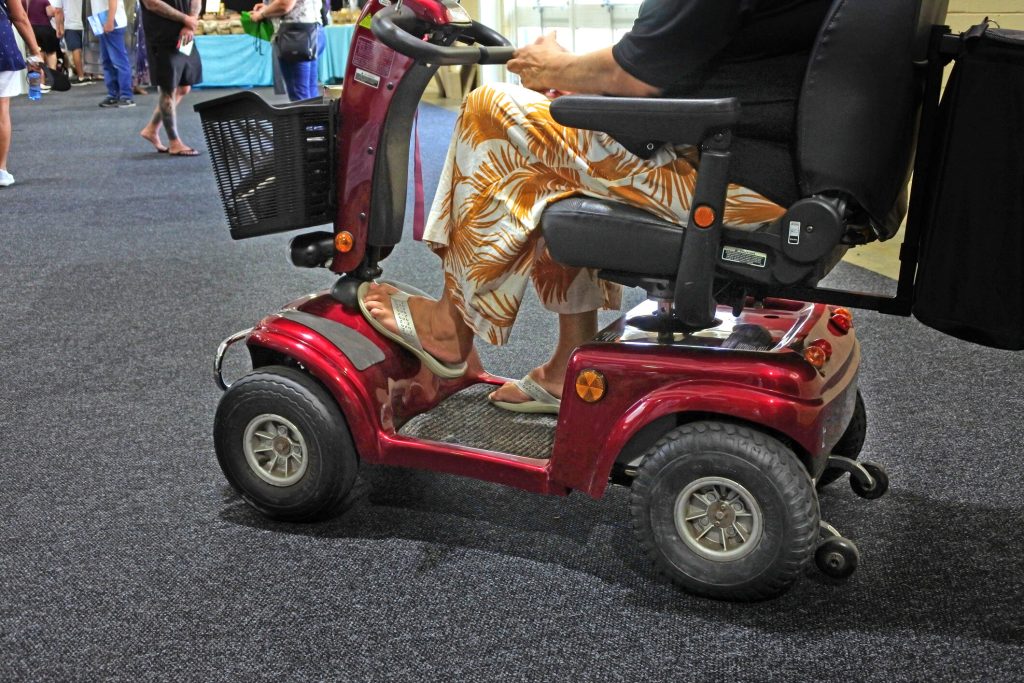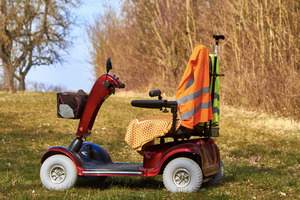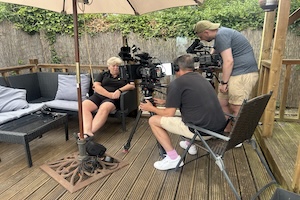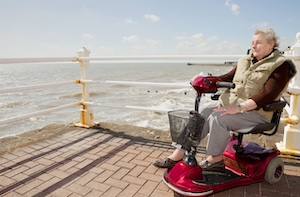When you acquire a mobility scooter, there is no test you have to pass, and no license you have to acquire. Whether or not that’s how things should remain is a hotly debated topic, but one thing is for sure: the onus is on you to be aware of the UK’s mobility scooter rules and regulations.
Keep yourself and others around you safe when out and about on your mobility scooter by staying up to date with the latest mobility scooter UK regulations, laws, and guidance. This article covers using your scooter both on the roads and on the pavements.

Other guides you might find helpful include this mobility scooter safety guide, staying safe on Your mobility scooter in autumn, and UK accessibility rights for mobility scooter users.
Getting a mobility scooter can be life-changing for many people, giving you a completely new level of freedom and independence if you have previously suffered from mobility issues.
If you’ve recently bought a mobility scooter, you probably can’t wait to get outside and try it out – but it helps to know the rules and regulations for mobility scooters in the UK first.
Working To Improve Mobility Scooter Safety
Our Safer Mobility Campaign launched back in 2024 with the aim of increasing the overall safety of anyone who uses a mobility scooter.
We have been driven into action by several alarming trends in recent years, namely:
- The number of fatalities among mobility scooter users nearly doubled in the 12 months to 2023
- A 20% year-on-year increase in mobility scooter casualties during the course of the last decade
We’re focused on raising awareness, changing attitudes by addressing outdated language, and helping to provide education to all relevant parties. A cornerstone of the campaign has been our call to add mobility scooter users to the Highway Code as a matter of priority, but the work doesn’t stop there.
Below, we’ve answered some of the most commonly asked questions on mobility scooter UK rules and regulations to better prepare you for getting out and about on your new scooter.
Do you have mobility scooter insurance? Do you need it? Find out and compare quotes to cover you and your mobility scooter insurance here.
Who Can Drive a Mobility Scooter?
Not just anyone can drive a mobility scooter! You can drive a mobility scooter only if you have a physical disability, or limited mobility because of an injury or medical condition.
The only exceptions are if you are demonstrating a mobility scooter before it is sold, taking the scooter to or from repairs, or if you are training a disabled user to use the vehicle.
Please see further information on this rule from the DVLA here.
What’s the Difference Between Powered Wheelchairs, Manual Wheelchairs, and Mobility Scooters?
If you’ve just started shopping around for a wheelchair or mobility scooter, you might be a little confused about what exactly each vehicle is – and what’s the difference between them!
Wheelchairs, powered wheelchairs and mobility scooters are considered ‘Invalid Carriages’ by law. Each of these vehicles has its own ‘class’, and its own set of rules and regulations that apply to this class:
- Class 1: Manual wheelchairs
- Class 2: Powered wheelchairs (max speed limit of 4mph)
- Class 3: Powered mobility scooters (max speed limit of 8mph)
Manual wheelchairs (Class1) and powered wheelchairs with a speed limit of 4 mph (Class 2) are designed for use on foot ways or pavements, while powered mobility scooters (Class 3) have a maximum speed limit of 8 mph and are equipped to be used on the road as well as the pavements and foot ways.
As a driver of any of the different classes of mobility scooters or Invalid Carriages, you’re required to obey the rules for other motor vehicles when you’re using the road. When you’re using the pavements or footpaths, the same rules that apply to pedestrians apply to you.
These rules and regulations are designed to keep you and the people around you safe – manual and powered wheelchairs are not designed for road use and disregarding these rules can be a great danger to everyone around you.
If you want to be able to specifically use the roads then considering a Class 3 powered mobility scooter may be the best option for you.
Can I Drive a Mobility Scooter on the Pavement?
Yes, you can ride a mobility scooter on the pavement. In fact, pavements provide more safety than roads and should be used whenever possible.
Class 2 invalid carriages cannot be used on the road and have a maximum speed of 4 mph, so this type of scooter actually must be driven on the pavement.
Do I Have To Give Way To Pedestrains?
Whilst using the pavements, pedestrians do have priority and you must be considerate of other pavement users. As a mobility scooter user, you share the pavement space with walkers, and it’s your responsibility to navigate safely around them. This means reducing your speed when pavements are busy or narrow, giving pedestrians plenty of space when passing, and being particularly mindful of vulnerable pedestrians such as children, elderly people, or those with visual or hearing impairments who may not be aware of your approach.
Is There a Speed Limit When Driving on the Pavement?
Yes, there is a speed limit when driving a mobility scooter on the pavement. You are legally required to travel at a speed of 4 mph or less on pavements and in pedestrian areas. Of course, you should go even slower if the pavements are busy or narrow.
According to Law UICHR 1988 reg 4, you have to obey the same rules as all other drivers or pedestrians so when you move from the pavement onto the road you are to ensure there are no obstructions or obstacles and that it is safe to do so. Look left, right and left again before crossing roads.
Is It Legal To Drive A Mobility Scooter Down The Road?
Mobility scooters are allowed on the road in the UK, provided they are a Class 3 vehicle and meet certain requirements as set out by the Driver and Vehicle Licensing Agency (DVLA).
These conditions required that mobility scooters may only be driven on the roads if they have a maximum unladen weight of 150kg, a maximum width of 0.85 metres, and are capable of travelling at 8 mph (12.8ph) on the roads.
What’s more, the DVLA requires that mobility scooters suitable for road use must have a working braking system with front and rear lights and reflectors, indicators, an audible horn, a rearview mirror, and an amber flashing light if the mobility scooter is to be used on a dual carriageway.
Do I Need a License for my Mobility Scooter?
No, mobility scooter users and powered wheelchairs in the UK do not require a driving license like you do when driving a car or other vehicle. Some mobility scooter types may require that you register them with the DVLA – you can find out more about this using the link above.
What Age Do I Need to Be to Drive a Mobility Scooter?
Mobility scooters can be an extremely useful addition to someone’s life if they have mobility issues, but there are age limits to ensure that the people driving a scooter can be safe and responsible when out on the roads or pavement.
To drive a class 3 invalid carriage, in other words, a powered mobility scooter as opposed to a manual wheelchair, you must be at least 14 years old.
There is no upper limit to driving a mobility scooter, and the mobility scooter laws UK users have to follow are exactly the same for everyone.
Do I Need Vehicle Tax For My Mobility Scooter?
Mobility scooters are exempt from paying vehicle tax if the maximum speed is 8-mph on the road, and they are fitted with a device that limits the speed to 4-mph on foot ways. The government website states that even if you don’t have to pay vehicle tax, you still need to apply for vehicle tax. You register for nil value tax.
The UK government subsidises the lease of mobility scooters under the Motability Scheme. There are different mobility scooter classifications for legal purposes, and there are certain stipulations for each class, like the speed limit per scooter and age restrictions, such as Class 3 mobility scooters where you have to be over 14 years of age.
If you want to register and apply for registration of Class III Invalid Carriage (three-wheeled vehicle), you’ll need to fill in a V55/4 form for a new vehicle, or a V55/5 for a used vehicle. The forms are available from the DVLA online ordering service.
Key Takeaways
- You cannot travel more than 4 mph on pavements or in pedestrianised areas, such as town centres
- Your mobility scooter must be capable of travelling at 8 mph (12.8 kmph) for you to use it on the roads
- You are responsible for the maintenance and upkeep of your mobility scooter
- Mobility scooter users are not currently part of the Highway Code, but we are working hard to change that!
Do I Need Insurance For A Mobility Scooter?
You are not legally required to have insurance for your mobility scooter. It is, however, strongly recommended to protect yourself against financial costs of repairs, third party liability should you hurt someone else with your scooter, as well as covering you against things such as theft, puncture repairs, and recovery.
Surewise offers mobility scooter insurance with cover for accidents, theft, puncture repairs, recovery and more. Get your quote here and give yourself the peace of mind that you’re covered against the unexpected when using your mobility scooter.
FAQ’s
Do You Need A Driving License For A Mobility Scooter?
No, you do not need to have a driving license or to have held one at any point in the past, to be allowed to ride your mobility scooter on the road. You must, however, be 14 years of age or older and ensure that your mobility scooter is registered with the DVLA.
Are Mobility Scooters Allowed On The Road?
To be allowed on the road, you must make sure that your mobility scooter is in a good state of repair and that it can reach a speed of at least 8 mph. This is known as a Class 3 mobility scooter and it must be registered with the DVLA before you can legally ride it.
You are allowed on all roads other than motorways, provided you follow the Highway Code. It is strongly advised that an amber flashing light is used when you are on a dual carriageway. This will help other road users know you are there so that they can keep a safe distance.
Can You Ride A Mobility Scooter On Medication?
Just as driving a car when your medication makes you drowsy is prohibited, the same is true of riding your mobility scooter. Mobility scooters can also not be used under the influence of drugs or alcohol, or if you are decision-making is impaired through any ongoing treatment you may be receiving. If in doubt, play it safe.
Am I Eligible For A Blue Badge?
Blue badges allow you to park in places that other drivers cannot – for example, parking spaces that are reserved for Blue Badge holders.
When you receive your Blue Badge, you can use it with any car, including taxis, hire cars you are driving, and cars you are travelling in as a passenger.
You will automatically qualify for a blue badge if:
- You are registered blind
- You receive a higher rate of the mobility component of the Disability Living Allowance.
- You are given the War Pensioners’ Mobility Supplement
- You have received a lump sum payment from the Armed Forces Compensation Scheme
However, you may still be eligible for the blue badge if you:
- Have a severe disability that affects your mobility
- Are unable to use your arms
- Have permanent problems walking








